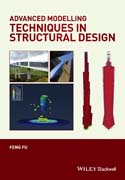
The successful design and construction of iconic new buildings relies on a range of advanced technologies, in particular on advanced modelling techniques. In response to the increasingly complex buildings demanded by clients and architects, structural engineers have developed a range of sophisticated modelling software to carry out the necessary structural analysis and design work. Advanced Modelling Techniques in Structural Design introduces numerical analysis methods to both students and design practitioners. It illustrates the modelling techniques used to solve structural design problems, covering most of the issues that an engineer might face, including lateral stability design of tall buildings; earthquake; progressive collapse; fire, blast and vibration analysis; non–linear geometric analysis and buckling analysis . Resolution of these design problems are demonstrated using a range of prestigious projects around the world, including the Buji Khalifa; Willis Towers; Taipei 101; the Gherkin; Millennium Bridge; Millau viaduct and the Forth Bridge, illustrating the practical steps required to begin a modelling exercise and showing how to select appropriate software tools to address specific design problems. INDICE: Preface iiThe Author iiiAcknowledgement ivTable of Content viTable of Figure xiIndex xviiiChapter 1 Introduction 11.1 Aims and Scope 11.2 Main Structural Design Problems 21.3 Introduction of Finite Element Method 31.4 Conclusion 8Reference 9Chapter 2 Major Modelling programs and Building informationmodelling (BIM) 9Abstract 92.1 Fundamentals of Analysis Programs 92.2 Building Information Modelling (BIM) 222.3 Main Analysis Programs in current Design Practice 232.4 Major Draughting Program 262.5 Method to Model Complex Geometry 27Reference 37Chapter 3 Tall Buildings 38Abstract 383.1 Introduction 383.2 Structural Systems of Tall Buildings 383.3 Lateral Resisting Systems and Modeling Examples 473.4 Modelling Example of Burj Khalifa 68Define 733.5 Modelling Example of Taipei 101 with tuned mass damper (TMD)743.6 Conclusion 79Reference 79Chapter 4 Earthquake Analysis of Buildings 79Abstract 924.1 Introduction 924.2 Basic Earthquake Knowledge 924.3 Basic Dynamic Knowledge 934.4 Modelling Example of the Response Spectrum Analysis usingSAP2000 1014.5 Time History Analysis and Modelling Example using SAP20001094.6 Push over Analysis and Modelling example using SAP2000116Reference 124Chapter 5 Progressive Collapse Analysis 125Abstract 1255.1 Introduction 1255.2 Design Guidance for Progressive Collapse Analysis 1255.3 Risk Assessment 1395.4 Design and Analysis Method 1405.5 Modelling Example of Progressive Collapse Analysis usingSAP2000––Non–linear Dynamic Procedure 143Reference 151Chapter 6 Blast and Impact Loading 151Abstract 1516.1 Introduction 1616.2 Fundamentals of Blast Loading 1616.3 Introduction of SPH Theory 1646.4 Modeling Examples of impact loading analysis using Coupled SPHand FEA Method in ABAQUS? 166Reference 184Chapter 7 Structural Fire Analysis 185Abstract 1857.1 Introduction 1857.2 Basic Knowledge of Heat Transfer 1857.3 Fire Development Process 1987.4 Fire Protection Method 1997.5 Fire Temperature Curve 2007.6 Determination of the Thermal Response of Structural Members2027.7 Structural Fire Design 2027.8 Major Modelling Techniques for Structural Fire Analysis2037.9 Modelling Example of Heat Transfer Analysis using ABAQUS204Reference 221Chapter 8 Space Structures 221Abstract 2218.1 Introduction 2348.2 Type of Space Structures 2348.3 Design Load 2398.4 Stability Analysis of Space Structure 2408.5 Modeling Example of a Single Layer Dome using SAP2000(including global buckling analysis) 2438.6 Nonlinear Geometric Analysis of Tensegrity Structures 2508.7 Modeling Example of Tensigrity Dome using SAP2000 (Non–linearGeometrical Analysis) 252Reference 260Chapter 9 Bridge Structures 260Abstract 2609.1 Introduction 2779.2 Structural Types of Bridges 2779.3 Structural Design of Bridge Structure 2819.4 Design Loading 2819.5 Modelling Example of Milau Viaduct using CSI Bridge 2839.6 Modelling Example of Forth Bridge using SAP2000 290Reference 298Chapter 10 Foot Induced Vibration 29810.1 Abstract 29810.2 Introduction to Vibration Problems in Structural Design31410.3 Characteristic of Foot Induced Dynamic Loads 31410.4 Acceptance Criteria 31610.5 Loading Representation of Foot Induced Vibration 31910.6 Modelling Example of Vibration Analysis for the MillenniumBridge using SAP2000 (Time Based Method) 32110.7 Modelling Example of Vibration Analysis of Hospital Floorusing ABAQUS? (Frequency Based Method) 32910.8 Reference 340
- ISBN: 978-1-118-82543-3
- Editorial: Wiley–Blackwell
- Encuadernacion: Cartoné
- Páginas: 288
- Fecha Publicación: 15/05/2015
- Nº Volúmenes: 1
- Idioma: Inglés
